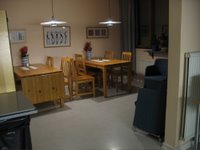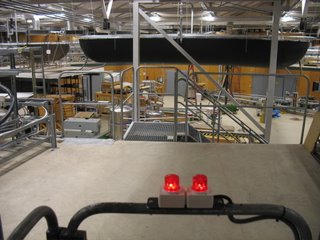
We wrapped up the last of the experiment runs about 7am, just a little before the synchrotron was dumped and a day of particle accelerator physics began. A whole gang of strangers started showing up in the kitchen having lunch and sporting toolbelts. There should have been a rumble, a turf war, or some kind of throwdown, but the users (those of us who are making use of the synchrotron light, and are not especially interested in having the synchrotron itself do anything other than normal operation) all seemed meek or downright absent while the tough new guys took over. All of which made it that much more appealing to clean up the work area, set out the leftover beer for whomever comes to work here next, and set out on a walk into downtown Lund.
 Lund is a very pleasant university town. The houses share walls and sit flush with the cobblestone sidewalks. People's potted plants and oil painting easels sit facing each other acrosss cobblestone streets where bicyclists comprise as much of the street traffic as the cars. In some places residential buildings have small courtyards between them where no rolling traffic could usefully go.
Lund is a very pleasant university town. The houses share walls and sit flush with the cobblestone sidewalks. People's potted plants and oil painting easels sit facing each other acrosss cobblestone streets where bicyclists comprise as much of the street traffic as the cars. In some places residential buildings have small courtyards between them where no rolling traffic could usefully go. The shopping streets have the same content as they do anywhere in the western world, but the town also features a nice big church which was open for tourists to quietly explore. The central cathedral was so exactly the typical soaring architectural edifice that to take pictures would have only been to repeat what had been done millions of times before.
The shopping streets have the same content as they do anywhere in the western world, but the town also features a nice big church which was open for tourists to quietly explore. The central cathedral was so exactly the typical soaring architectural edifice that to take pictures would have only been to repeat what had been done millions of times before.  But the crypt was a bit more personal, if I ignore the English signs bearing laminated A4 laserprinted verses labeled with Station Numbers. The weather was bleary, which matched my mood and made the light in the crypt solemn and tranquil.
But the crypt was a bit more personal, if I ignore the English signs bearing laminated A4 laserprinted verses labeled with Station Numbers. The weather was bleary, which matched my mood and made the light in the crypt solemn and tranquil.  The flash would have made taking photos at odds with the feeling of the place and given the pictures a tourist look, but a close look reveals that leaving it off also exposes my need for a pocket-sized tripod of some kind.
The flash would have made taking photos at odds with the feeling of the place and given the pictures a tourist look, but a close look reveals that leaving it off also exposes my need for a pocket-sized tripod of some kind.It was a little after midnight local time when I woke up from an eight-hour blanket drill and walked down the block to the lab to make braekfast from the food we keep there. Before I left, I wanted to document the spacious, clean kitchen at the guest house. Next time I come here, maybe we can have more dinners in this place.



Even in the dead of night, the preparation and eating areas are homey and inviting. I didn't do too badly at the lab: musli with lemon yogurt, toast and marmalade, the big black grapes with three bitter seeds inside. There was even some mjolk left for my kaffe med socker. I could happily spend a year with a postdoctoral position in this place.

 Still, it will be nice to get home. I'm excited to get to see again all the cool folks whom I've been trying to keep along with me through these pages. I'll be waking up about 16 in the afternoon when I get back on good old fashioned American, (well, Eastern) time. So I'm also looking forward to when everyone else has gone to bed and the cat and I will stay up through the wee hours, plotting evil genius plots. It's obvious to anyone who has met him that he's an evil genius, so I don't think he'll mind it if I say so here.
Still, it will be nice to get home. I'm excited to get to see again all the cool folks whom I've been trying to keep along with me through these pages. I'll be waking up about 16 in the afternoon when I get back on good old fashioned American, (well, Eastern) time. So I'm also looking forward to when everyone else has gone to bed and the cat and I will stay up through the wee hours, plotting evil genius plots. It's obvious to anyone who has met him that he's an evil genius, so I don't think he'll mind it if I say so here.Thanks for reading. Talk to you soon.
 -jmsj
-jmsj













































